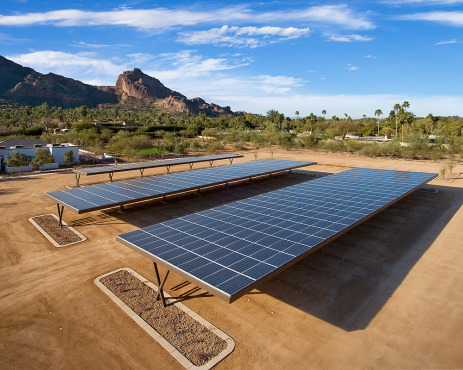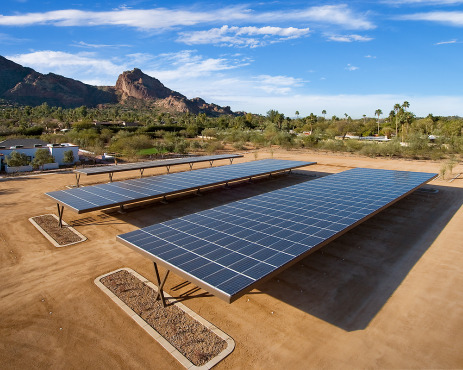 A REC solar carport in Paradise Valley, Ariz.Photo: REC SolarEvery time I fly over Phoenix, Las Vegas, or some other sprawling sun-scorched Southwest city, two thoughts come to mind: Who had the bright idea of putting black shingles on all those desert subdivisions, and why aren’t those roofs covered in solar panels?
A REC solar carport in Paradise Valley, Ariz.Photo: REC SolarEvery time I fly over Phoenix, Las Vegas, or some other sprawling sun-scorched Southwest city, two thoughts come to mind: Who had the bright idea of putting black shingles on all those desert subdivisions, and why aren’t those roofs covered in solar panels?
Apparently the administrators at the Southern Arizona VA Health Care System in Tucson had the same idea. This week REC Solar, a California company, announced a deal to install a 2.9-megawatt photovoltaic array on the hospital’s carports. That’s in addition to the 302-kilowatt system ground-mounted system REC Solar currently is building for the veteran’s hospital.
At 2.9 megawatts, the new parking lot installation will apparently be the nation’s largest solar carport complex and will supply a big chunk of the 900,000-square foot facility’s electricity demand. (At peak output, an array of that size would be able to supply electricity to roughly 3,000 average-sized homes, provided their owners didn’t run the air conditioning 24/7.)
The solar panels generate electricity while the carports will help to keep the vehicles underneath cooler. Three years ago, Google put solar panels on carports at its sprawling Silicon Valley headquarters and then installed electric car charging stations in the parking spaces. A San Diego company called Envision Solar builds “solar groves” — tree-like carports with solar panel canopies — in parking lots for companies such as Dell.
While the Arizona deal highlights the opportunity to generate clean electricity from parking lots — those vast wastelands that symbolize the nation’s oil addiction — it also underscores the government’s role in driving demand and creating a market for green technology.
While the Obama administration has doled out billions of dollars in stimulus money for renewable energy projects, it has also directed federal agencies to practice what it preaches. That means increasing the energy efficiency of the government’s own huge real estate holdings, replacing federal automotive fleets with cars that run on alternative fuels, and generating electricity from renewable energy.
As I wrote earlier this week, the United States military has become one of the biggest green forces. The Navy, for instance, is aiming to cut its dependence on fossil fuels in half by 2020 by converting ships to run on electric hybrid propulsion systems, fueling fighter jets with biofuels, and installing everything from smart meters to solar arrays at all naval bases.
In other words, there’s a lot of government carports out there ready to go solar.



